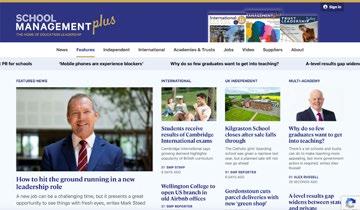SCHOOL INTERNATIONAL magazine



Helping teenagers to reconnect



























schoolmanagementplus.com
Our School Management Plus online platform offers a wealth of information.
Keep up to date and get involved:
• latest news, regular features and opinion
• monthly newsletter and jobs to your inbox
• contribute your own ideas and opinion
• join our webinars and round-table discussions.


We are the leading opinion platform for the successful running of a modern International school. We are always keen to hear about the issues that matter to you most, so get in touch to have your school’s voice heard. editor@schoolmanagementplus.com

NEWS
4 Colin Bell from Cobis explores a new project to improve safeguarding in international education.
WELLBEING
6 Helen Kelly explores why it’s so important for international school leaders to learn to switch off from work.
FOCUS ON: EAL
9 Laura Spargo looks at how international school teachers have been helping EAL students to flourish in the classroom.
12 EAL provision needs to change in international schools to adapt to changing demographics, explains Lydia McKenzie from ISC Research.
LEADERSHIP
14 International school leaders need preparation for a unique set of challenges, writes Mark Steed.
HOW WE DID IT
16 An innovative programme at The British International School of New York is re-engaging upper school students and strengthening school culture.
TECHNOLOGY
19 Torben Lundberg looks at how technology is revolutionising international education.
EDITOR’S PICK
26 The cost of international education – Gerardo Robledillo sniffs out the most expensive – and cheapest – countries.
28 Spotlight on a School – Exploring Svitlo online school.

The leading source of news, opinion, features & jobs for all professionals working in independent and international education. @ International School News




ON THE COVER
Nigeria is a powerhouse for global education’ – interview with Adam England, head of the new Rugby School Nigeria.

The new BISSC safeguarding code for international schools aims to improve recruitment in transnational education settings, writes Colin Bell
At this year’s recent COBIS annual conference, the British International Schools Safeguarding Coalition (BISSC) announced the launch of its Safer Recruitment Code of Conduct.
It is a landmark framework designed to reduce risk and further support, promote and strengthen safeguarding standards across British international schools and the wider sector.
Founded in late 2023, BISSC was born from a collective recognition among leading school associations that safeguarding challenges – particularly in the international space – demanded a more unified and strategic response.
While schools and associations have long prioritised child protection, fragmented standards, inconsistent practice, and gaps in global recognition of safe recruitment left
room for improvement. The coalition brings together seven major organisations:
• The Association of British Schools Overseas
• British Schools in the Middle East
• The Council of British International Schools
• The Federation of British Schools in Asia
• The Latin American Heads Conference
• The National Association of British Schools in Spain
• The Safeguarding Alliance (TSA)
‘The code is not about inspection – it’s about intention.’

Why was the BISSC Safer Recruitment Code of Conduct produced?
Safe schools begin with safe hiring. Recruitment is the first gateway into any school community, and yet international settings face disproportionate risks –varying vetting practices, global mobility of staff and students, regulatory loopholes, and limited legal recourse.
BISSC recognised that existing national frameworks, while robust, often fall short in global transnational settings where jurisdictions and expectations diverge. This new Code of Conduct addresses these gaps and serves to reduce risk.
What the code does
Coming into effect from 1 September 2025, the BISSC Safer Recruitment Code
‘Fragmented standards, inconsistent practice, and gaps in global recognition of safe recruitment left room for improvement.’
of Conduct offers a unified approach to recruitment, tailored specifically to international contexts. The code outlines expectations across the recruitment journey – from job advertisements and application processes, to pre-employment checks, interviews, and onboarding. Its focus is threefold:
1. Promoting rigour and transparency:
The code sets a high bar for due diligence, background checks, and reference verification. It encourages schools to go beyond compliance and embrace a culture of vigilance and that “it could happen here”.
2. Ensuring accountability:
By committing to the code, schools signal their accountability to their wider communities – students, staff, parents, and peers. The document serves as both a mirror and a guide: it helps schools identify gaps in their processes while also affirming best practice.
3. Fostering continuous improvement:
The code is not static. It is a living document that reflects the evolving nature of safeguarding risks. BISSC will review and adapt the code as needed, ensuring its relevance remains strong as schools and systems grow.
The code provides a practical and accessible resource for schools to use and adapt, regardless of location or size. For some schools, it will complement existing safeguarding protocols; for others,
‘Safer recruitment is not just a policy tick box.’
it will provide a first foundation. In all cases, it offers reassurance to families, governing bodies, and regulators that a BISSC-aligned school is serious about safer recruitment and all other aspects connected to safeguarding.
This document helps demystify what “good” looks like in safer recruitment. It also reduces ambiguity for HR teams, school leaders and governors by clarifying expectations for school leaders, and places the responsibility for safeguarding squarely at the heart of strategic planning and operational delivery.
Importantly, the code is not about inspection – it’s about intention. Schools won’t be measured by their perfection, but by their commitment to doing better, together.
The BISSC Code is just one step in a broader effort to raise standards and support schools globally. As we look
ahead, BISSC will continue to act as a hub for collaboration – sharing knowledge, research, and resources to help school communities navigate the complex challenges of safeguarding; where the finishing line is never crossed.
We know that documents alone don’t protect children – people do. But strong frameworks empower people to act with confidence, clarity, and care. With this new Code of Conduct, BISSC is proud to offer a tool that does just that.
We encourage all international schools, whether already connected to a BISSC association or not, to read the code, to engage with its recommendations, and to reflect on how they can further strengthen their safer recruitment practices.
This is because navigating and plotting a course to transnational safer recruitment is not just a policy tick box, a glorified standard or a vacuous statement on a website or job ad.
It is instead our sector’s “golden thread” – our collective responsibility to reduce, and, in an ideal world, eliminate risk for children and young people worldwide. ◆
Colin Bell is CEO of the Council of British International Schools


International school leaders work better when they can learn to switch off from work – but it’s a challenge, writes
Dr Helen Kelly
Ihave written before about the worrying increase in the rates of chronic stress, exhaustion and burnout among the international teaching profession. An educator’s work is highly demanding, requiring high levels of physical, mental and emotional energy.
Yet the majority are failing to take time to switch off and recover, with massive implications for health, quality of life and job performance.
Studies show that psychological detachment is the central experience of recovery from work-related stress. Just as the body requires sleep to physically replenish, the mind needs periods of detachment to recover from the mental and emotional demands of work.
Regular detachment from work reduces the levels of stress hormones in our body, decreasing feelings of anxiety and increasing a sense of control over our lives. It also improves the immune system, making it easier to fight off illness, reducing our chances of developing heart disease and other long term health conditions.
Yet my own (unpublished) research is indicating that 75 per cent of educators consider their inability to switch off to be the major contributing factor to a poor work-life balance and 89 per cent worry it may be affecting their health. So why is it hard for us to switch off? Research shows the main barriers to switching off are the following:
• Long working hours combined with poor homework boundaries and constant accessibility.
• Emotionally intense working conditions coupled with lack of emotional support.
• Rumination over things that have happened or might happen.
• A general inability to relax.
How can we switch off?
The ability to switch off can be learned and improved over time. We know that tiny changes to habits can have a big impact, if they are implemented consistently and built up incrementally. These lifestyle changes should focus on reducing working hours, establishing

work-home boundaries and seeking emotional support to help manage the emotional demands of the work. They should also include using strategies to help us decompress, by embedding relaxing activities or employing relaxation practices, being intentional about finding “me time” and engaging in hobbies and pastimes that bring a sense of purpose or achievement. Finally, we should develop techniques to help reduce rumination and break the cycle of overthinking.
Work-home boundaries
Less than a quarter of school leaders feel they have good work-home boundaries in place. The key to establishing effective boundaries these days revolves a lot around our use of technology. Starting the day with non-work thoughts is a highly effective strategy to delay the initiation of our stress response and set us up for a calm and positive day. This means putting off reaching for our phones on waking and instead engaging in brief physical exercise, taking a bath, journalling or eating breakfast in the garden.
Likewise at the end of the day, we need to build friction to make the use of technology harder and reduce our accessibility. I have learned from others that the following techniques can be highly effective.
• Setting the Do Not Disturb function on your phone.
• Having a separate work phone with clear guidance to colleagues and parents on the times you are available and when it is “emergencies only”.
• Using a Digital Detox Box – a physical box or drawer where you lock way your devices
• Removing all but essential notifications.
• Deleting apps, such as school email, from the homescreen to make it harder to check.

Techniques to reduce rumination include:
‘The ability to switch off can be learned and improved over time.’
• Limiting engagement in school-related WhatsApp groups and resetting the expectations of colleagues around this.
• Leaving the laptop at school or using a different computer, browser or profile for home
• Employing apps specifically designed to help manage device use such as Opal, Freedom, StayFree, Forest and OneSec.
• Using an old fashioned alarm clock to keep the phone out of the bedroom.
One school leader told me recently that she has a child lock on her laptop in the evenings and weekends and only her husband knows the password. She finds this highly effective.
In a recent study I conducted, 77 per cent of school leaders report that they always or usually ruminate over things that have happened or might happen at school. Overthinking is highly damaging to our health and job perfomance, causing insomnia and in the longer term contributing to high blood pressure and heart disease. We know that we experience more stress ruminating in the aftermath of a meeting with a colleague or parent than we do in the meeting itself.
• Recognising and acknowledging you are ruminating, asking yourself: “Am I problem-solving, or just going in circles?” This labelling helps activate the brain’s regulation system rather than the stress response.
• Externalising your thoughts by writing them down.
• Using “worry time” or a “worry window” of 10 to15 minutes when you allow yourself to ruminate and postpone ruminating outside of that time to the next “worry window”.
• Physical movement – to disrupt the rumination loop and bring a fresh perspective.
• Cognitive defusion – this puts a distance between you and your thinking and can include saying “I am having the thought that…because…”, saying the thought in a funny voice or repeating it aloud until it loses meaning.
While the educator’s work remains so highly demanding, learning how to embed these switching off practices gives us back some control over wellbeing and provides us with opportunities to unplug, reclaim our lives and restore our balance.
To find out how well you switch off and receive feedback and tips, take part in the survey Unplugged: How well do school leaders switch off? surveymonkey.com/r/KRFXXQX ◆
Helen Kelly is a former international school leader now working as a speaker and consultant, helping to improve the wellbeing of school communities.

Create your own visual learning resources in your web browser using over 20,000 Widgit symbols, and translate them into more than 80 languages.
Use the Dual Language feature to help English Language Learners access the curriculum and develop their communication skills with confidence.
Gemma Donovan, Head of Whole School EAL, South View School, Dubai “
We’ve seen a clear impact on engagement and inclusion; students are now more confident, independent, and active in lessons.























































Laura Spargo looks at how international school teachers have been helping EAL students flourish in the classroom
As anyone who has taught in a multilingual classroom will know, students with EAL face challenges which set them apart from native speakers. But learning a language at a young age also gives children a superpower which serves them well throughout their education and beyond.
A 2024 study from the Institute of Education shows that early multilingual exposure creates long-term academic benefits for multilingual students, compared to their monolingual peers.
But it’s up to schools to ensure students make the most of these benefits.
These are some of the strategies my colleagues and I are using in multilingual settings.
1
Provide tools to access the curriculum
Students with EAL must develop their understanding of the curriculum while also acquiring a more academic form of English, which takes longer to embed in the memory than everyday speech.
This raises additional barriers to learning and can leave children feeling tired and overstimulated.
When students are at an early stage in their learning, physical movement can help with vocabulary recall. Some
schools use the Total Physical Response (TPR) method, based on the way children learn their mother tongue.
Orlaith O’Carroll, inclusion teacher at Charter Schools UAE, finds this approach effective. “If children are able to link a word with an action, they are more likely to remember that word. I have been teaching children some key classroom vocabulary, such as pencil and whiteboard, using TPR. TPR connects a word with an action, for example a teacher writing on a whiteboard or a child using a
pencil. The student can help to create the actions themselves, and this serves as a powerful memory aid for them.”
For academic subjects, we often pre-teach vocabulary in advance of a lesson, to give children an advantage when they access the lesson content later on. Translanguaging, which is the practice of encouraging students to use their first language alongside English, can also deepen students’ understanding of the higher tier vocabulary they need for a lesson, such as “cell” or “dissolve”.
2
Create an inclusive environment
When a child with EAL starts at a new international school, some aspects of school life can seem confusing, particularly if they differ from the child’s previous setting. Younger children might wonder when it’s time to listen to a story or play outside. For an older student, navigating a packed timetable of subjects in an unfamiliar language can be daunting. If children are worrying about the school routine, F

they find it harder to enjoy activities, or focus on learning. One of the approaches that works well is to provide a visual representation of the day ahead. A now/next board is ideal for young children, with a simple illustration such as a Widgit Symbol to represent story time, followed by another showing outside play. Older children benefit from a full visual timetable of school subjects, including symbols for geography or science alongside the written word.
Home/school collaboration is key. If you can share these visuals with families, the child can chat through the day ahead with parents or carers at home, which further strengthens the child’s understanding of their new routine.
When children understand what is going to happen, they feel confident and ready to learn.
Learners with EAL need support to develop social
communication skills, and playing games which involve sharing information can be a key way of doing this. Activities where children have to describe objects to each other to complete a task work particularly well. For instance, asking a partner for a certain colour or shape of a Lego piece so they can build a model.
When children work together in small groups to create a story, it can inspire them to be creative and suggest ideas. This is most effective when using a visual prompt, such as a symbol of an animal, a favourite toy, or a musical instrument.
Learners with EAL need to practise their spoken language skills as much as possible. When children hear good language role models, they are likely to emulate those skills themselves. Exercises where you pair a child with a more able English speaker can model good communication.
Alternatively, buddies with the same first language can
share ideas at a richer, more nuanced level, and explore more abstract concepts such as feelings and emotions, as well as curriculum vocabulary.
As the Institute of Education research suggests, multilingualism can put students at an academic advantage, but for this to happen, students need the confidence to take part in classroom activities and discussions.
To alleviate anxiety, it can help to give children the opportunity to work with a partner and practise what they are going to say before speaking to the whole class. It can also be reassuring
Laura Spargo is an education consultant, primary English curriculum specialist and former head of primary English at Kings’ School Al Barsha, Dubai.
for a child to refer to a visual aid so they develop the confidence to tackle a task independently.
Charlotte Goode, assistant head of primary at GEMS Winchester School UAE, uses flipcharts with symbols to support Year 1 to 3 pupils with EAL.
She says: “Children can decode what a task is asking them to do without having to ask the teacher immediately. This fosters a more confident learning environment and encourages students to engage actively in their lessons.”
When combined with the support of their teachers, friends and families, strategies like these can help to empower multilingual children and ensure that they reach their true potential. ◆




As
international school demographics change, schools are
moving away from the ‘deficit view’ of English proficiency
By Lydia McKenzie
The international schools market continues to expand globally, with almost 15,000 schools now accommodating over 7.4 million students – a 45 per cent growth in enrolment over the past 10 years.
In ISC Research’s new white paper, Meeting the Challenges of Shifting Student Demographics: EAL Provision in International Schools, we explore how rising student numbers impact the cultural and linguistic diversity of international school classrooms.
Countries with growing economies and multinational corporations continue to attract expatriate families, many of whom choose international schools for their English-language instruction and globally recognised qualifications.
However, in some markets, local student enrolments now account for up to 70 per cent of the student body – highlighting a global shift towards blended international and local curricula, bilingual programmes, and multilingual learning environments.
This evolving international school
as an Additional Language (EAL) provision. Schools must ensure that their approaches reflect the increasing diversity of student nationalities and acknowledge that, in some contexts, the majority of learners may be classified as EAL. What current practices are being implemented, and where do opportunities exist for further development?
The evolution of EAL provision Traditional EAL provision has often involved withdrawing students from mainstream classes for targeted, interventionist language instruction. This model can provide a structured and supportive space for risk-taking and language development, but it naturally isolates learners from their peers. It also reinforces a deficit view of English
proficiency – where language acquisition is framed as something to be “fixed”, and limited English skills are mistakenly equated with limited intellectual ability.
As the number of EAL learners increases in many schools, this approach is becoming increasingly unsustainable and misaligned with inclusive, whole-school practices.
In response to the limitations of traditional models, many international schools are reimagining their EAL departments as “multilingualism” departments, acknowledging the diverse linguistic backgrounds of their students and positioning language learning as a strength rather than a barrier. This shift reflects a broader move towards integrated, collaborative practice, where language support becomes a shared responsibility across the entire school community.
Rather than being treated as a peripheral concern, language support is embedded across the curriculum, with mainstream educators and language specialists collaborating to design lessons that all students can access and thrive in. They recognising that language acquisition is not an isolated process, but one deeply connected to context and culture.
Whole-school approaches to EAL
To explore how this modern approach to EAL and embracement of multilingualism is being implemented in practice, we
‘Local student enrolments now account for up to 70 per cent of the student body.’

spoke with three leaders in the field: Gemma Donovan, head of EAL at South View School Dubai, Jacob Huckle, head of multilingual learning at Dulwich College Suzhou, and Valerian Goguadze, dean of students and EAL specialist at International School of Estonia.
South View School Dubai
Rather than encouraging students to set aside their linguistic backgrounds in favour of English, Gemma Donovan promotes the integration of these languages as a foundation for deeper engagement and academic success. At South View School Dubai, this approach is reflected in teaching strategies that move beyond monolingual models. Instruction is scaffolded to support access to complex vocabulary, including pre-teaching key terms, and embedding regular vocabulary revision. As Donovan notes, no student is a native speaker of academic language, making these strategies essential for all learners and not just those identified as EAL.
This inclusive philosophy also allows for a more holistic understanding of each student’s potential. Multilingual learners often excel in non-verbal cognitive tests, such as CAT4, whilst still developing their English literacy. By providing students with opportunities to demonstrate their knowledge beyond English, students are empowered to see themselves as competent and capable across disciplines.
Donovan says: “You can’t teach a multilingual class in a monolingual way. We must adapt our teaching methods to ensure all students, regardless of their language background, can access the curriculum.”
Introducing new pedagogical strategies is only the beginning; lasting change towards a whole-school multilingual culture requires a shift in underlying beliefs and attitudes. At Dulwich College Suzhou, Jacob Huckle
‘Traditional EAL provision reinforces a deficit view of English proficiency.’
‘Many international schools are reimagining their EAL departments as multilingualism departments.’
advocates for the “head, heart, and hand’” model of professional development:
• The “head” represents knowledge – engaging educators with research on language acquisition, challenging misconceptions, and deepening their understanding of why specific strategies are effective.
• The “heart” symbolises empathy –raising awareness of the experience and challenges of language learning and the importance of designing lessons with all students in mind.
• The “hand” represents teachers’ practical skills: do they have the resources needed to produce language-rich lessons? Do they need support in developing clear communication skills and building confidence in a multilingual classroom?
For professional development to be truly effective and for change to be sustainable, all three dimensions must be addressed with equal intention. When aligned, they enable schools to embed multilingualism not just in policy or practice, but in culture.
“Once teachers recognise that teaching a subject includes teaching its language, they become more creative and proactive in supporting multilingual learners”, Huckle says.
International School of Estonia
Parents are an integral part of the wholeschool community and play a crucial role in supporting student success in language development – particularly through sustained engagement with the curriculum. Valerian Goguadze has implemented a range of strategies to actively engage parents with the school’s language policy and to promote a shared understanding of the value of multilingualism:
1. Interactive parent workshops: Workshops help parents understand language development milestones and ways to support learning at home.
International School of Estonia hosts coffee mornings where parents learn about approaches to learning and engage in discussions about their child’s education.
2. Individual meetings: At regular intervals, meetings are held with parents to discuss their child’s language background, assessment results, and individual learning plans.
3. Multilingual support: Provision of translated materials including WIDA assessment reports allow parents to understand their child’s progress.
4. Parent-teacher handbook: Creating a simplified handbook outlining school procedures and expectations. These strategies not only build trust and transparency, but also position parents as informed partners in fostering a school culture where multilingualism is valued and actively supported.
Goguadze says: “Language barriers create challenges, but there are always ways to bridge the gap. Whether through translated materials, digital tools, or school-organised workshops, we find solutions together.”
Embracing multilingualism in international schools
As international schools continue to grow and diversify, the need for effective EAL provision has never been more critical. With growing enrolments from both local and expatriate families, schools are moving beyond traditional models to a more inclusive approach that recognises multilingualism as a strength rather than a barrier.
To explore the challenges educators face in delivering effective language support, and the evolving role of technology, download ISC Research’s free white paper, Meeting the Challenges of Shifting Student Demographics: EAL Provision in International Schools. ◆
Lydia McKenzie is the communications assistant at international schools market consultants ISC Research.

Nothing prepares you for the first day as a headteacher – all the more so in my case as, in my mid-thirties, I went from being a boarding housemaster to the headship of a small, rural independent school. I leapfrogged those important apprenticeship roles of assistant and deputy head. The first SLT meeting I ever attended, I found myself chairing.
International school leaders need preparation for a unique set of challenges, writes Mark Steed and then people will start coming through the door expecting you to make decisions. You’ll work it out.”
And so it proved.

I had no idea what to expect taking up the reins. A wise headteacher for whom I had worked at Oundle School, UK, advised not to overthink it: “You’ll sit at your desk for ten minutes wondering what the job is,
‘The first SLT meeting I ever attended, I found myself chairing.’
Headship was different in 2001: safeguarding had just been invented, inspection was in its infancy, the head’s secretary was the HR department, and schools were still judged on the performance of their first teams, rather than on examination results and league table positions. It was a gentler era, so being thrown at the deep end was less of a shock than it would be today. Fortunately, we have better systems in place to prepare the next generation of school leaders.
‘The modern international school is a complex business.’
Earlier this year, I had the great privilege to be one of the “co-facilitators” (we didn’t have those in 2001 either) of the Cobis Programme for Aspiring Headteachers (CPAH). The programme seeks to put in place some practical tips to allow school leaders to make the important transition from being on the SLT to running a school.
The CPAH runs over a period of eight to ten months. It combines six days of face-to-face sessions, including three days around half term of Term 1; and three days at the end of Term 2, further online sessions, and a choice of in-school projects and optional school placements.
The course covers a lot of the traditional leadership course material exploring leadership styles, how teams work, leading and managing change and how to develop a strategy.
However, what is great about the CPAH is its international focus and its flexibility to incorporate in a range of important topics that are rarely covered on courses of this nature. For example, we had a great discussion of how the head’s role differs when working in a for-profit school context from a not-for-profit one. We also considered what are the implications of working in a overseas franchise.
One area of school leadership training I am particularly passionate about is fostering greater understanding of and insight into the business side of schools. The modern international school is a complex business, often with hundreds of employees, a real estate of thousands of square of metres, and a turnover that runs to tens of millions of pounds.
Few senior leaders have much visibility of how the school budget works and how to go about balancing the books, so the first days of headship, and certainly the first finance meeting of the board, can be quite a daunting experience.
As headteacher you will be responsible for appointing significant numbers of teaching and support staff, so it is essential that you have a sound working knowledge of local employment law and HR practices. When do we learn this?
Courses like the CPAH cannot cover all of these areas in detail, but they can make a start by simplifying some of the specialist language. For example, most school budgets are very simple to understand: 95 per cent+ of the income comes from school fees, so pupil numbers drive income; and 60-75 per cent of the costs are staffing, so learning ways to get control of the staffing budget is the key to keeping costs down.
‘There is still a danger that we throw senior leaders in at the deep end.’

The course devotes significant time to those areas where headteachers have already had experience from their time on the SLT. Two stand out for me:
Most members of an SLT are insulated from having to deal with governors and owners. One of the great skills that heads have to develop is the ability “to manage up.” Governors are often volunteers and they have other professional responsibilities which mean that they are not always available.
Anyone who has been a headteacher for any length of time will recognise that the relationship between the chair and the head is key. However, this is a whole new world for the aspiring head. What a course like the CPAH can do is to give some idea of what a normal relationship between the head and the chair might look like; and share some tips on how to maintain a clear line between governance and executive responsibilities.
The role of the head has evolved hugely over the past 23 years. Schools are significantly more complex and accountable organisations than they were then. The days of being a housemaster as a qualification for headship have certainly gone, and courses like the CPAH are certainly a great help in filling in some of the gaps.
But there is still a danger that we throw senior leaders in at the deep end. Boards have a significant role to play by allowing senior leaders to attend governors’ meetings as observers, particularly meetings that pertain to finance and strategy. So do principals and headteachers who need to take their aspiring senior leaders under their wing and mentor them to a greater understanding of what it is to do the top job. ◆
Mark Steed is the former head of Kellett School, Hong Kong and JESS, Dubai. He is the founder of Steed Education consultancy and is currently working as interim principal and CEO at Stamford School in Lincolnshire, UK.




An innovative programme at The British International School of New York is re-engaging upper school students and strengthening school culture, by Wavell Blades
At British International School New York (BISNY), we recognized the challenges that our Upper School students (ages 14 to 18) faced in engaging meaningfully with the school community. Many students, particularly in an international setting, felt disconnected from their school environment. This prompted the introduction of the Citizenship Awards, a unique initiative designed to encourage students to contribute to their school and the wider community in ways that go beyond academics.
The problem: Student disengagement
in a global school community
International schools often face the challenge of students feeling disconnected due to
their diverse backgrounds and the transient nature of the student body. For our Upper School students, this disconnection became more noticeable as they focused on preparing for university, leaving them less engaged in schoolbased activities that promote community connection.
At BIS-NY, we observed that many of our Upper School students were not participating in the extracurricular and community-building activities offered. This lack of involvement
resulted in a diminished sense of belonging, a crucial factor in student wellbeing and success. We needed an initiative that would motivate students to invest more time in activities that fostered a positive school culture while developing leadership skills.
The solution: Introducing the Citizenship Awards
To address disengagement, we introduced the Citizenship Awards. This
‘Many of our Upper School students were not participating in extracurricular and community-building activities.’
initiative was designed to recognize students for their contributions to the school and the broader community, separate from their academic performance. The goal was to create a system that rewards leadership, kindness, and social responsibility –values central to personal growth and strengthening the school culture.
Students earn points through a range of activities such as:
1. Volunteering at school events.
2. Taking on leadership roles in clubs.
3. Participating in schoolwide initiatives.
4. Supporting peers through mentoring or community service. These contributions, often overlooked in traditional academic grading, are essential for developing character, responsibility, and leadership qualities. As students accumulate points, they work towards an invitation to the Citizenship


Banquet, a celebratory event where they can showcase their contributions and be recognized in front of their families and peers.
Nature of the work:
Fostering long-term engagement
The Citizenship Awards are designed to be both a recognition system and a motivational tool for students. Unlike traditional academic awards, which focus solely on grades and test scores, this programme celebrates the broader development of students as they engage with their school community.
A key challenge in implementing this initiative was ensuring that it was accessible and engaging for all students, regardless of their academic abilities. To solve this, we developed a flexible points system that rewards a variety of activities – from smaller acts of kindness, such as helping younger students, to organizing larger charity events. This inclusivity ensures that all students have the opportunity to contribute in meaningful ways.
The programme encourages
‘As students accumulate points, they work towards an invitation to the Citizenship Banquet.’
participation by making it clear that there is no single path to earning points – every contribution, big or small, is valuable and contributes to the overall culture of the school. It also provides students with the autonomy to choose how they engage, fostering a sense of ownership over their involvement.
Building school and community connections
While the Citizenship Awards primarily focus on engaging students internally, it also strengthens relationships with the wider community. Students are encouraged to collaborate with local businesses and organizations, participating in charity fundraisers and community service projects.
For example, students have partnered with local organizations such as Riverkeeper and The Bowery Mission to raise funds and volunteer for community projects. These partnerships not only help students understand social responsibility but also give them real-world experience in event planning, leadership, and community service.
In addition to engaging students with the external community, the Citizenship Banquet strengthens the relationship between the school and parents. This event provides a space for families to celebrate their children’s achievements, further
reinforcing the importance of community involvement and recognizing the value of nonacademic contributions.
The Citizenship Awards have received positive feedback from students, teachers, and parents. Students have become more involved in extracurricular activities, and there has been a marked increase in leadership roles taken by Upper School students in clubs and school events.
Feedback surveys show that students feel more connected to the school and more motivated to contribute to their community. Many students have shared that being recognized for their efforts outside the classroom has given them a greater sense of purpose and pride in their school. This recognition has been crucial in motivating students to remain engaged and take on leadership roles in school activities.
We have also seen an increase in the number of students attending the Citizenship Banquet, with over 30 per cent of Upper School
students attending in 2025. This growing participation rate demonstrates the value students place on this recognition and highlights the success of the programme in fostering a sense of community.
One of the major strengths of the Citizenship Awards is its sustainability. The flexible design of the programme allows it to grow and adapt to meet the needs of the school community. What began as a response to student disengagement has evolved into an integral part of our school culture, promoting long-term student engagement and leadership development.
The Citizenship Awards are also easily replicable in other schools. The points system can be adapted to fit schools of various sizes and resources.
At BIS-NY, the programme has had a lasting impact on the school culture, creating a community where students feel valued not just for their academic achievements but for their contributions to the school environment.
Wavell Blades is deputy head of The British International School of New York. Previously, he had a career in UK state education, including as assistant head (personal development, behaviour and welfare) at King’s College Maths School in London.








takes a look at the ways in which technology is supporting learning, gamechanger, and its thoughtful use can hugely enhance learning and contribute to
particular, edtech can play a crucial role in breaking down language and cultural barriers, supporting students with their learning experiences, while also helping teachers to simplify administrative tasks. Communication with parents can be much
At Inspired Education, we have invested heavily in developing our own suite of tools to support teachers, pupils and parents
across our group of more than 120 schools.
But while we embrace the latest technological advancements, it’s important to maintain a balanced approach, building on the foundations of traditional, proven educational methods.
For international schools, the metaverse has opened up a whole new landscape of opportunity, not only to bring about multi-language collaboration, but to enable students to visit important, historical or culturally relevant locations, virtually.
For example, students learning Spanish are able to work closely with native F

‘Students can perform plays together in the metaverse.’
Spanish-speaking students, conversing and participating in various activities with the use of VR headsets, no matter where they are based.
Meanwhile, students learning Shakespeare are able to collaborate with native English-speaking students and perform plays together in the metaverse. They can even do so at a virtual Globe Theatre, gaining an in-depth and immersive experience of what it was really like to be an actor performing one of Shakespeare’s plays in London.
Similarly, during history lessons, students can explore and participate in a powerful custom-made Anne Frank experience inside a virtual recreation of her secret annexe. This immersive experience allows them to better understand her story, reflect on the impact of war and discrimination, and engage with historical empathy in a meaningful, memorable way.
The use of VR technology across our group has shown significant impact on both students and teachers alike. In a recent survey about the use of VR, 90 per cent of students reported increased engagement and interest in their lessons, while 85 per cent of teachers found virtual and mixed reality to be a valuable tool to enhance their teaching. What’s more, 72 per cent of students and 85 per cent of teachers said using VR helps them to recall information –a vital skill on their education pathway.
The very nature of international schooling means there is often regular movement of students to and from any given school and technology can help with this. There are many reasons why students may relocate, whether that’s because of their parents’ jobs, due to family lifestyle choices, or for particular educational needs. Students may be going on a year-long exchange programme, they may be moving campus, or they may be moving from primary to secondary school.
It can however be nerve-racking for parents to relocate their child to another school, where they might lose access to all their academic information, their child might be studying a new curriculum with new systems, new homework formats, new teachers and so on.
Being part of an international school group means it is far easier to change schools, and thanks to technology you can now retain all students’ grading, learning history, textbooks and reports, ensuring a seamless transition for students. They can move schools easily without losing their coursework and learning data, they can follow what the school is doing while they are away and then they can pick up where they left off, when they return.
In this way, a student living in Switzerland studying their GCSEs, might choose to spend a term in the Bahamas at
another school from our group, and our tech provision would make the transition seamless.
Within any international school, there will likely be a wide range of native languages spoken by students and international schools can also offer different curricula, depending on location and intake. But the beauty of AI is that it can be used to adapt content to different curricula and languages.
AI tools can also remove much of the administrative headache from teachers so they can spend more time actually teaching their students. An example of this is the Cycle Test, which every class from Year 4 upwards across Inspired schools takes each Monday morning, as a means of assessing their progress and attainment. The introduction of AI has meant that the entire process is optimised, from preparing the tests and sending them out, to collecting the papers to mark and feeding back to students. The technology is simplifying teachers’ workload so they can spend more time focused on the students themselves.
At international schools, there is a greater need to cater for families’ cultural and language differences, and technology can help.
Across our group, the Global Study Platform provides students and their parents with personalised access to everything from academic progress and school reports, to homework, textbooks and resources, grades and attendance, as well as extracurricular activities and financial information. This can all be delivered in the language that parents choose, driven by AI.
In recent years, the technological advancements across education have been enormous, but, to my mind, there is still no end to the possibilities of how edtech can enhance the learning experiences for students at international schools. ◆


From edtech to teacher training, Nigeria is the place to get things done in education, says Dr Adam England
IInternational School Magazine asked Dr Adam England (AE), what drew him to his new role as founding principal at Rugby School Nigeria, what makes education in the country unique, and how international curricula are changing for the better in Africa.
Why did you choose to work in Lagos leading Rugby School Nigeria?
AE: Anyone who knows me knows I like Africa, and I like a challenge, which is helpful as the two often go hand-in-hand. That said, the challenges are proportional

to the rewards, both personal and professional, as you can get so much done in Nigeria so quickly because of people’s work ethic and capacity to innovate.
Compared with some OECD countries where the attitude to educational change is sclerotic, to say the least, the approach to trying something new in Nigeria is invariably refreshing.
I had wanted to return to Lagos since 2021, and it was exactly the sort of opportunity I had been looking for. I had already spent three years there as a principal and I loved my colleagues’ approach to improving practice with appropriate training and to using technology to solve educational problems.
Professional development is taken as a given in Europe but less so in Africa. So when it is offered, either in person or with an online platform across the school, it is taken seriously and people build their professional capacity rapidly in line with their own
needs and the strategic direction of the school. This, of course, means you can move forward speedily with strategic development.
Lagos “gets” me and I “get” it. I know it’s got a dark underbelly – all cities do. But the belief that tomorrow will be better than today on the basis of a positive attitude and hard work is reminiscent of that traditional British resilience that saw us through two world wars and other global challenges.
Rugby’s philosophy is neatly encapsulated by the maxim “The Whole Person, The Whole Point” and that, I think, sums up Lagos. School is there to make you a better person; it’s a character engine and culturally, a perfect match for Rugby’s outlook.
Nigeria and Rugby are made for each other. They are a close cultural fit, the salt and pepper of the educational world.
What have Europeans got wrong about education in Nigeria and Africa?
AE: I could write another PhD thesis about this.
Suffice to say that the era of wholesale importation of Eurocentric education systems, ie. whitewashed history curricula and so on taught exclusively by expats, is long gone and quite rightly so.

Morally, it’s clearly correct that such thinking is seen to be very last-century but practically, it should be too. For example, when I was a principal for the first time in Nigeria, I was struck by the facile adherence of curricula to European content models: why were boys and girls learning about coastal erosion in Britain when Nigeria offered equally vibrant and visible models?
Similarly, why were conflicts like the Second World War taught only from a European perspective?Why not look at that of the Burma Boys, the 120,000 or so Nigerians who signed up for the British army to fight against the German and Japanese armies?
Unsurprisingly, when we started to blend our GCSE and A-level curricula with more local content – Chimamanda Adichie’s magnificent Half of a Yellow Sun was introduced in literature, Nigerian cuisine was brought into home economics, solving safety problems on the Third Mainland Bridge (the longest bridge in Africa) was introduced into science – pupil performance improved significantly. This was the case especially among boys, as the curriculum instantly became less abstract and a lot more “real” and there. The other notable failing of the European approach to education in Africa is the under-estimation of local F
teachers’ malleability and flexibility when it comes to change management.
High-tech problem solving
AE: For most Nigerians, problem-solving and the resourcefulness and resilience to do so effectively are part of daily living. This was typified by the young truck drivers I saw one day at the roadside using a smartphone, a Youtube video, a pair of pliers and a length of cable to re-secure the propshaft on their ancient Bedford truck. This was one of many examples I witnessed of Nigerians blending technology and resourcefulness to problem-solve.
Another good example of this propensity to innovate was how easily you could get an app developed. Within a kilometre of school, there were numerous proficient app developers capable of delivering a mini-platform for you for about £500.
And before you think Africa might lag behind Europe on the tech front, consider this. By 2021, at least one school had developed a facial recognition system to log the presence of all students and staff into and out of campus.
Likewise, all staff in my last school were Microsoftcertified and deployed this effectively to establish knowledge-creation structures for pupil learning that facilitated collaboration and skilled problem-solving of real-world projects.
Similarly, online self-differentiating curricula were up and running by 2020 and being used regularly and impactfully, especially by SEND learners to augment their learning. Interestingly, these proprietary curricula allow the teachers to do the human things that teachers are good at – empathy, creativity, building accountability, supporting emotional wellness etc – by taking on the chores that AI is good at – assessment, differentiation and adaptation of curricula content.
Of equal significance is how seldom these selfdifferentiating AI-generated curricula are deployed in the UK compared with the international landscape which is an illustration of the advances international education is making compared with the domestic scene.
To sum up, African curricula need to be more Afrocentric and there needs to be an industry-wide acknowledgement of the fact that Nigeria is a growing
powerhouse for global education with well-trained, motivated and highly cerebral teachers who are the equal of any other country; as the saying goes, what is there not to like?
Why are Nigerians opting for international schools in their own country rather than going abroad?
AE: To a certain extent, this is already answered by what I’ve said – schools are blending European and African content in their curricula, making them more relevant and accessible, and curricula are being delivered by a motivated workforce. In many ways, it’s a living ideal of educational aspirations and rightly attracts numerous Nigerian parents. Other important socio-economic factors are influencing parents’ decisions. Those in the diaspora in the UK are being hit hard by the imposition of VAT on school fees meaning that an international education in Nigeria now represents far better value for money than one in the UK. At Rugby School Nigeria, for example, fees for a day pupil start at a little less than $25,000 with a pioneer discount (which we will offer for entry this year), meaning any parent could put two children through Rugby School Nigeria for the price of one in the UK.
It is self-evident that if a quality international education is available locally, most parents would prefer their 11- or 12-year-old children to stay at home, enjoying their local community, cuisine and church rather than send them to board in another country. This, of course, is now an option with the advent of a prestige school like Rugby School Nigeria and it is no coincidence that many parents are now taking this option.
Lastly, what are the challenges and joys of setting up a leading British international school in Nigeria?
AE: Interestingly, the challenges are mostly controllable – you can mitigate for infrastructure, climate and diseases like malaria. And the joys? Always the pleasure of interviewing students, staff and parents and watching their engagement with our culture will be top of the list – schools are nothing without humanity. Overseeing and contributing to the construction of our school comes a close second – who wouldn’t want the chance to be involved with the creation of such an impressive entity from scratch? ◆
Dr Adam England is principal of the new Rugby School Nigeria, opening in September. He was previously director general of Ecole Ruban Vert in Libreville Gabon, principal of CIS Lagos and headteacher of Focus School Swansea from 2004 to 2017.





















































































































































































45,000+ independent & international professionals
15,000 social media reach accross six channels
Included in weekly jobs newsletter

















































Standard listing PLUS
Featured listing at the top of the Careers Section
Advertising alongside relevant content throughout the site
ATTRACT THE BEST STAFF WITH THE LEADING DIGITAL PLATFORM FOR INDEPENDENT AND INTERNATIONAL SCHOOL PROFESSIONALS WORLDWIDE
School Management Plus is the leading print, digital and social content platform, for leaders, educators and professionals within the independent and international education sector worldwide.
Our readership spans every stakeholder within fee paying education worldwide from Heads, Governors, Bursars, Admissions, Marketing, Development, Fundraising and Educators – to catering, facilities and sports. Our jobs & careers center is the natural meeting point for those already in the sector, aspiring to join it, or hiring from within it.





























Featured listing PLUS









Free listing if the vacancy is not filled
Included on magazine digital distribution to 150,000 readers
Included in school directory
Listing experience hosted on Kampus24






















Premium listing PLUS
Unlimited job listings throughout the year to our audience
Newsletter presence every month for your school
Exposure and features on your school in main careers section
Print adverts for your listings each term
Listing experience hosted on Kampus24
The rst 100 schools to sign up will receive 20% o a year’s unlimited package
•Social following of 15k across 6channels
• 60% annual growth in web tra c
• Core readership of Heads, Senior Leaders, Heads of Department, Bursars and Finance managers, Marketing and Admissions, and Development across the sector
The UK and Switzerland have the highest international school fees in Europe, but New York leads the world, writes Gerardo Robledillo
Anew study by the International Schools Database has revealed that the cost of international education varies significantly across the globe. This extensive analysis, which examined international school fees in 82 cities across 53 countries, offers a crucial overview of the financial landscape for international families.
New York City stands out as the most expensive location
for international schooling, with a median annual price soaring to $44,600 (£33,200). This figure highlights the premium associated with education in major global economic hubs. Conversely, Ipoh-Perak in Malaysia offers the most affordable option, with a median annual fee of just $2,725 (£2,030). This vast difference underscores the diverse economic realities and educational market conditions worldwide.

‘New York City stands out as the most expensive location for international schooling.’

Globally, the United States, China, and Switzerland consistently rank as the priciest countries for international education. These nations often host highly developed international school sectors, catering to a significant expatriate population. In contrast, Africa emerges as the least expensive region overall, suggesting more accessible options for international education across the continent. Asia, however, presents a paradox, as it encompasses both some of the most expensive and most affordable cities.
Delving into regional specifics, Europe’s international school market shows

considerable variation.
Switzerland and the United Kingdom lead the continent as the most expensive countries, with median prices often exceeding $20,000 (£14,900) annually. Zurich, in particular, records the highest median price at $30,738 (£22,902) per year, underscoring its status as a high-cost educational destination.
Interestingly, Spain offers some of Europe’s more budget-friendly international school options, with Tenerife noted as the cheapest at $4,903 (£3,652) per year. Most European countries included in the research typically report median prices ranging between $10,000 (£7,449) and $15,000 (£11,176) annually.
Unexpectedly, cities such as Riga in Latvia and Budapest in Hungary are also found among the top 10 most expensive European cities for international schooling,
going against the trend of Western European dominance in high costs.
In the Middle East, DubaiSharjah-Ajman recorded the highest median price for international schools at $10,883 (£8,109). However, the region exhibits a relatively narrow range of median prices, with about $4,500 (£3,352) separating the highest and lowest median fees. Manama in Bahrain and Amman in Jordan offer the lowest median prices in the Middle East, both under $7,000 (£5,215) per year.
The Americas demonstrate a significant cost divide, with the United States being considerably more expensive than other countries in the region, including Canada.
The top four most expensive cities for international schools in the Americas are all located in the US: New York City ($44,600 or £33,231 median), San Francisco Bay Area ($33,450 or
£24,923 median), Washington D.C. area ($25,915 or £19,309 median), and Chicago ($23,700 or £17,659 median).
Conversely, Latin American cities such as Lima, Panama City, and Monterrey show relatively consistent and lower international school costs, with median prices around $8,000$9,000 (£5,961-£6,706) per year. The difference in median prices between North America and Latin America is stark, with the closest comparison (Toronto vs. Monterrey) still showing a more than 100 per cent increase.
Africa, while generally the least expensive region, also
‘Switzerland and the United Kingdom are the most expensive countries in Europe.’
presents internal variations. Nairobi, Kenya, stands as the most expensive city in Africa, with a median price of $7,116 (£5,303). This is notably higher than the next most expensive city, Johannesburg ($5,657 or £4,217), and the least expensive, Cairo ($2,966 or £2,211). South Africa itself shows a considerable difference between its major cities, with Johannesburg being 30 per cent pricier than Cape Town. Mauritius, on the other hand, exhibits the lowest range of costs within Africa, with prices between $2,491 (£1,857) and $6,881 (£5,129). This global and regional data illustrates the complex factors influencing international school fees, from economic prosperity and currency values to the demand for international curricula and the supply of high-quality educational institutions.
To explore the full findings and detailed data from this research, you can read the complete report on the International Schools Database website: The Cost of International Education Around the World in 2024. ◆
Gerardo Robledillo is the co-founder of International Schools Database.
A software engineer turned entrepreneur, he has lived as an expat in various corners of the world since 2005.


From online English lessons in bomb shelters to a global network of support, Yuliya Kosko tells how she founded a unique school serving young Ukrainians
In February 2022, the Russian invasion of Ukraine turned my world upside down.
Although I moved to the UK in 2004, to study and become a primary school teacher, I was born in Zaporizhzhia, a Russian-speaking industrial city in southeastern Ukraine.
‘When the invasion began, my first instinct was to rush back to Ukraine and help in any way I could.’
When the invasion began, my first instinct was to rush back to Ukraine and help in any way I could. I reached out to my former school in Zaporizhzhia and offered online English lessons, as schools were closed and children were forced to seek shelter from the constant bombardments. This simple act of reaching out sparked the beginning of Svitlo School. Svitlo, meaning “light” in Ukrainian, was founded to provide a sanctuary for Ukrainian children amidst the chaos of war. It’s more than just an online school; it’s a place where students can learn about democracy, improve their English, and find respite from the harsh realities of their daily lives.
The traditional Ukrainian curriculum is heavily focused on grades and core subjects, often lacking
in the development of crucial interchangeable skills, teamwork abilities, high-level English proficiency, and career guidance. Svitlo fills this gap by offering Ukrainian children the opportunity to connect with native English speakers from around the globe and participate in lessons on subjects such as debating, economics, business, politics, public speaking, and English literature.
We empower our pupils to take on projects that develop leadership skills and cultivate democratic values, opening up a world of possibilities through our dedicated international volunteers.
Svitlo School fosters a supportive social structure where students can connect with peers, earn house points, and collaborate on team projects. Students can choose from up to eight subjects daily, including weekend sessions, and even lead their own clubs or become reading buddies for younger pupils. This holistic approach provides not only academic enrichment but also a sense of community and purpose during a time of immense disruption.
The resilience of Svitlo’s pupils is truly inspiring. Despite power cuts, air raid sirens, and sleepless nights, many students attend 30-35 lessons a week. Some have lost their homes and loved ones, yet they channel
‘I hope that the work of Svitlo School will last far beyond the war.’
their grief into building a brighter future through education.
One student, on a full bursary at Harrow School Online and living in Zaporizhzhia, achieved three A*s a year younger than his cohort, barely leaving his room amidst the ongoing war. Our volunteering teachers, many of whom are qualified educators in the UK, consistently describe the children as the most enthusiastic, polite, and grateful pupils they have ever taught. As Mathew, a teacher with over 30 years of experience, put it: “I have to pinch myself after every lesson to make sure I am not in teacher’s heaven.”

build relationships and connections through the online school as well as fundraising.
“At a time of so much geo-political uncertainty it matters so much that students can feel agency and that they are connected to something positive and bigger than themselves.”
There are now around 1,100 student connecting to Svitlo weekly – more than 2,500 have taken part over the last three years at some point. There are 53 active teaching volunteers and 21 older current pupils who teach English or reading with younger pupils.
Svitlo has garnered incredible support from British and international schools, staff, and students. Sixth formers from Aiglon College in Switzerland and pupils from University College School in London have facilitated discussion clubs for Ukrainian teenagers. Norfolk House Primary in North London partnered with Svitlo for a joint assembly, leading to a pen pal project. Norfolk House pupils organised a charity run on Hampton Heath, raising over £7,000 for Svitlo Education.
Svitlo has had incredible support from British and international schools, staff, and students.
Harrow School Online and Highgrove Online School students have successfully led clubs at Svitlo, with teachers volunteering their time and the principal, Heathe Rhodes, serving as a trustee, sharing expertise on high-quality online learning.
Feedback from these partnerships highlights the mutual benefits: cultural exchange and global awareness, social impact and perspective-building, collaborative learning and innovation, and civic engagement and volunteering.
Emmie Bidston, housemaster and teacher of economics at Wellington College, whose Year 12 pupils paired up with Svitlo pupils via the Global Social Leaders platform, collected books and funds to provide English books for bomb shelters through the Svitlo Reads initiative, said: “Working with Svitlo has provided the perfect opportunity to take positive action to support Ukraine, because of the chance to
Jonathan Harper, founder of Global Social Leaders, said that international students have much to learn about resilience and perseverance from Svitlo pupils, highlighting the profound impact of this crosscultural exchange.
For me, it was not easy to start a charity without previous experience of fundraising, and I am still learning. Svitlo changed my life, and the lives of those involved every day. Volunteers often thank us for the opportunity to make a difference. One day spent by a child in a war zone is one day too many, and we must therefore work extra hard, and fast.
I hope that the work of Svitlo School will last far beyond the war. We teach skills which are important for all career paths and subjects like: Anti-corruption, democracy, debate, media literacy, investment etc are not taught in the Ukrainian curriculum but crucial for the future of independent Ukraine.
Ukraine is being torn apart. Education must be a priority. Now is the time to invest in the children, traumatised by the war so they grow up into educated adults who will lead the postwar country into a democratic, stable future with excellent English knowledge, diplomatic skills and liberal principles.
By empowering children today with a global perspective and democratic values, we will get a generation of leaders who will make Ukraine into a prosperous country, a contributor to Europe’s and the independent world’s global work and trade. ◆

Yuliya Kosko is the founder of Svitlo School. She was born in Ukraine but came to Britain in 2004 to study and became a primary school teacher. She now advises international families on navigating the British education system.